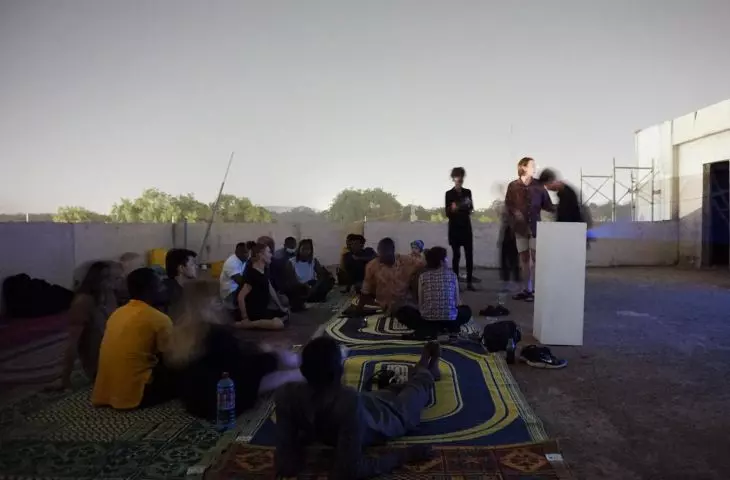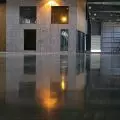African architecture and culture is still an underestimated potential. Have we freed ourselves from colonial thinking in its context? What is Afrofuturism and what role does it have to play in Africa? We talk about the architecture of Africa and the need to change our thinking with Magdalena Górecka, lecturer at the Institute of Architecture in Vienna, designer and architect.
Wiktor Bochenek: This year's Pritzker Prize winner is Diébédo Francis Kéré, a Burkina Faso-based architect working in Berlin? Has the architecture world finally taken notice of African architecture with its different needs and requirements?
Magdalena Górecka: Definitely. I see it changing rapidly since I started working in the West African region. I myself remember being in Burkina Faso, wanting to visit most of the buildings that Diébédo Francis Kéré designed. This included the village of Gando, whose chief is his Father. A great many people visit Burkina Faso specifically for Kéré's architecture - even though it is a dangerous area. Much has also changed for the women of the region. There are new awards and organizations such as African Female Architects and the African Futures Institute. In addition to Kery, mention should also be made of Lesley Lokko, who curated the 2023 Venice Architecture Biennale, and the new Serpentine Pavilion 2023, designed by black artist Theaster Gates. Lesley Lokko's speech following her appointment as curator is worth reflecting on: "A new world order is emerging, with new centers of knowledge production and control. New audiences are also emerging, thirsting for different narratives, different tools and different languages of space, form and place. After two of the most difficult and divisive years in our memory, architects have a unique opportunity to show the world what we do best - to present ambitious and creative ideas that will help us imagine a more equitable and optimistic collective future. As I address you from the world's youngest continent, I would like to thank President Cicutto and the entire La Biennale di Venezia team for this bold, courageous choice." I think these words say a lot about the future of architecture and the world's new centers of innovation.
classes in Tamale
© [APPLIED] FOREIGN AFFAIRS
Wiktor Bochenek: Are we freeing ourselves from the fallacy of colonial thinking when thinking about Africa?
Magdalena Górecka: In a way, yes. People coming from France or the UK have a completely different perception than me coming from Poland. It is difficult to answer the question unequivocally. Our generation looks at things differently than our parents. These changes are and will be more and more visible.
Wiktor Bochenek: What is Afrofuturism based on?
Magdalena Górecka: Afrofuturism is the idea of a future that is filled with, art, science and technology seen through an Afrocentric prism, without Western, Eurocentric elements. What distinguishes Afrofuturism from traditional science fiction is that it is deeply rooted in the culture of African peoples. The celebration of liberation - a move away from colonial patterns- is also an important element.
Wiktor Bochenek: It's hard not to get the impression that the culture of Africa is still undiscovered for us, how can we learn about it, how can we avoid a "colonial approach" in this? How can we discover Africa?
Magdalena Górecka: I think the most important thing is the approach. You have to look at Africa as a continent of innovation and potential. Afrofuturism, which shows a very positive solarpunk future, can also be useful for this. For example, through the film Black Panther, showing visions of the African state as developed, open to women and highly developed. This can be seen in the visions of Congo Astronauts or Osborne Macharia. It is also important to look at architects and women architects from the region. A big problem lies in the fact that people are afraid to travel to sub-Saharan Africa, which is often irrational. In Ghana, where she works, she feels very safe. It's also a good idea not to be afraid to go outside the larger towns or live in smaller villages for a while.
The most important thing is attitude. In Africa you can see a lot of innovation and amazing cultures and interesting technologies.
Magdalena Górecka
© Carmen Egger
Wiktor Bochenek: You have designed together with modelsoffbeauty residential and commercial complexes located in Ghana or Senegal. What is most important when designing for Africa, facing a completely different scale of problems?
Magdalena Górecka: I think that, the most important thing is unlearning - unlearning what is standard on many levels in the design process. It's also important to look at spatial layouts or materials differently. A positive view of the future of the continent, or solarpunk, is very important. In my works you can see different branches of Afrofuturism and solarpunk. In The Otherwordliness, I designed a network of artifacts in the south of Spain. They are located between the world created with plastic greenhouses. Through these structures I create another world of the Third Cinema, or Nigerian Nollywoood. It belongs to amateurs and is cheap, fast and democratic. Nollywood films are created with smartphones and then projected onto large screens of smartphone proportions. Artifacts include gardens, a wellness area, swimming pools and all engulfed in reflections of color from the color screens. Digital Oyster, on the other hand, is a fortress for women. A fortress where they can hide and get away from the monotonous life in the countryside. It has thick walls that absorb sound, gardens, a library and halls where they learn independence through digitization. They can create content, and earn Mobile Money, a pan-African way of paying by phone. It's a very solapunk vision of women's liberation and independence, creating a selective club where men are not allowed in.
The latest Tamale Mini-Living project proposes a way of living together and creating a community that revolves around healthy eating and sports, as the project was commissioned by the owner of the award-winning and largest gym in northern Ghana, TamaleFit. Tamale Territories Fictions, is one of the labs I run with [Applied] Foreign Affairs at the University of Applied Arts in Vienna we have created an interdisciplinary team, where everyone has a different learned profession and different experiences. In architecture today, the skills of the architect alone are not enough. At Tamale Territories, my students worked in such mixed teams. Not only professionally, but also in terms of culture and nationality. One group worked with artist Tracy Thompson, who creates unique artifacts made from food waste. By layering it, it becomes very structural, making it usable later.
Tamale Mini-living design by Magdalena Górecka
© Modelsoffbeauty
I think this type of material should be the building block of the future, and young architects should experiment rather than use a standard solution, which has resulted in the environmental crisis we live in. My students have a so-called ban on 2D drawings, i.e. projections, sections, unless it is necessary. They create their designs, or architectural narratives, using smartphone apps. In addition, they design with the idea of Solarpunk, or superpositive vision of the future. This is the opposite of cyberpunk and shows a utopian vision. By showing and creating such visions, change is possible. This my prohibition of conventional methods of representing space allows you to get out of stereotypical thinking about buildings and conventional spatial solutions.
Wiktor Bochenek: I think it's important that local residents participate in these activities and projects.
Magdalena Górecka: This is very important. This is what unlearning came from. We have to unlearn a lot of things and look at things anew through the lens of the community. In Tamale, where we are working in one of the last green areas, the students for the first few days just watch and listen to what the reality is. It's never the case that we go, do and leave. At many universities, when organizing such projects, activities end with design, and then these structures get old and deteriorate. In the work of an architect in this part of the world, it is very important to work on the building, but after it is built. Possibly more important than the design itself. A lot of young people, treat building there as an experiment, which is created and then abandoned. There are no resources or organizations there to take care of such public buildings. With us, it's different. We come back every six months or more, and observe what is happening with these constructions. Then we also invite the community to participate in discussions. Integration is very necessary.
participants in the activities
© [APPLIED] FOREIGN AFFAIRS
Wiktor Bochenek: What does such an unlearning process look like? What can we as Europeans do to improve the living conditions of Africans while not falling into the trap of colonial thinking?
Magdalena Górecka: We don't come there to help, and we don't want to think of ourselves that way. We come there as space specialists who meet specialists in agriculture, irrigation, art, painting and so on. We first learn from them the process itself, so that we can then try to contribute something to improve the space. It's a joint teaching and knowledge exchange, which is worth noting, on the same level. My students are mixed with master's and doctoral students from Ghana. This exchange is very important. Who are we to help them, or tell them what development looks like? We can support, but certainly not impose.
Wiktor Bochenek: Thank you for the interview!
presentation of effects after the class
© [APPLIED] FOREIGN AFFAIRS






























